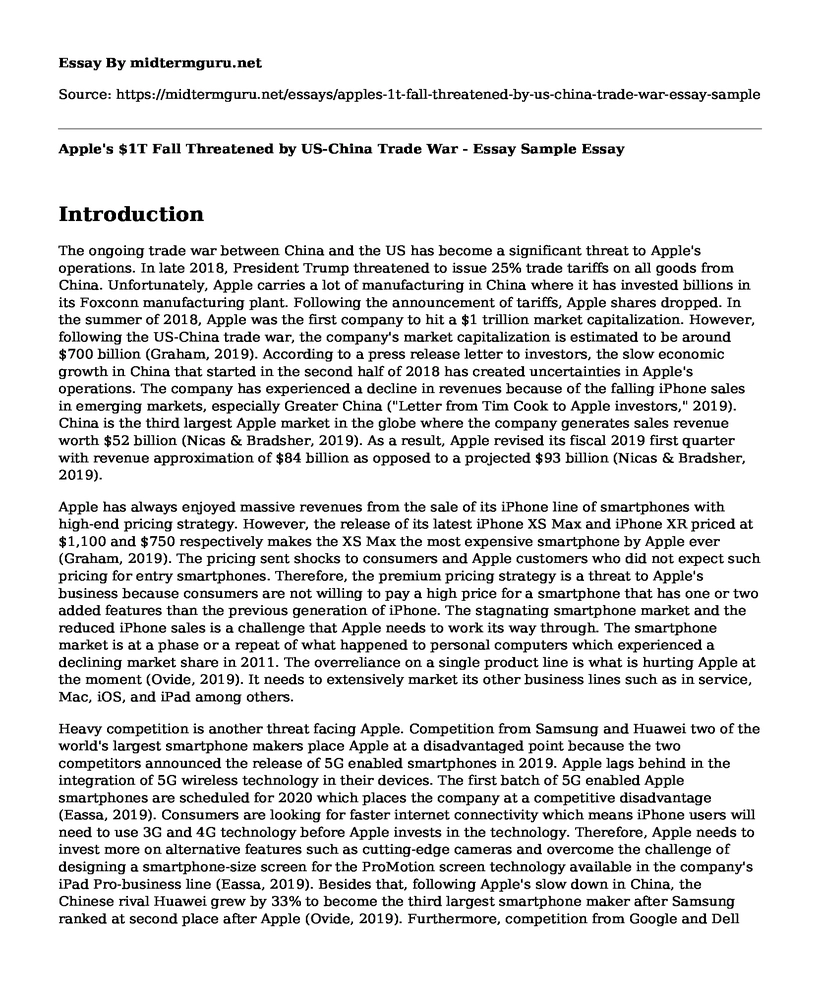Introduction
The ongoing trade war between China and the US has become a significant threat to Apple's operations. In late 2018, President Trump threatened to issue 25% trade tariffs on all goods from China. Unfortunately, Apple carries a lot of manufacturing in China where it has invested billions in its Foxconn manufacturing plant. Following the announcement of tariffs, Apple shares dropped. In the summer of 2018, Apple was the first company to hit a $1 trillion market capitalization. However, following the US-China trade war, the company's market capitalization is estimated to be around $700 billion (Graham, 2019). According to a press release letter to investors, the slow economic growth in China that started in the second half of 2018 has created uncertainties in Apple's operations. The company has experienced a decline in revenues because of the falling iPhone sales in emerging markets, especially Greater China ("Letter from Tim Cook to Apple investors," 2019). China is the third largest Apple market in the globe where the company generates sales revenue worth $52 billion (Nicas & Bradsher, 2019). As a result, Apple revised its fiscal 2019 first quarter with revenue approximation of $84 billion as opposed to a projected $93 billion (Nicas & Bradsher, 2019).
Apple has always enjoyed massive revenues from the sale of its iPhone line of smartphones with high-end pricing strategy. However, the release of its latest iPhone XS Max and iPhone XR priced at $1,100 and $750 respectively makes the XS Max the most expensive smartphone by Apple ever (Graham, 2019). The pricing sent shocks to consumers and Apple customers who did not expect such pricing for entry smartphones. Therefore, the premium pricing strategy is a threat to Apple's business because consumers are not willing to pay a high price for a smartphone that has one or two added features than the previous generation of iPhone. The stagnating smartphone market and the reduced iPhone sales is a challenge that Apple needs to work its way through. The smartphone market is at a phase or a repeat of what happened to personal computers which experienced a declining market share in 2011. The overreliance on a single product line is what is hurting Apple at the moment (Ovide, 2019). It needs to extensively market its other business lines such as in service, Mac, iOS, and iPad among others.
Heavy competition is another threat facing Apple. Competition from Samsung and Huawei two of the world's largest smartphone makers place Apple at a disadvantaged point because the two competitors announced the release of 5G enabled smartphones in 2019. Apple lags behind in the integration of 5G wireless technology in their devices. The first batch of 5G enabled Apple smartphones are scheduled for 2020 which places the company at a competitive disadvantage (Eassa, 2019). Consumers are looking for faster internet connectivity which means iPhone users will need to use 3G and 4G technology before Apple invests in the technology. Therefore, Apple needs to invest more on alternative features such as cutting-edge cameras and overcome the challenge of designing a smartphone-size screen for the ProMotion screen technology available in the company's iPad Pro-business line (Eassa, 2019). Besides that, following Apple's slow down in China, the Chinese rival Huawei grew by 33% to become the third largest smartphone maker after Samsung ranked at second place after Apple (Ovide, 2019). Furthermore, competition from Google and Dell has become a challenge to Apple. For instance, Dell has specialized in the computer market that is actively challenging the MacOS line of Apple computers.
Conclusion
Conclusively, Apple is facing tremendous obstacles that hurt the company's dominance in the tech industry. The US-China trade war, overreliance on a single market and line of products, 5G technology, and stiff competition are key threat affecting Apple. The company needs to move swiftly to overcome its adversities before it is too late.
References
Eassa, A. (2019, March 03). Apple Is Going to Be Late to 5G -- So What? Retrieved from https://www.fool.com/investing/2019/03/03/apple-is-going-to-be-late-to-5g-so-what.aspx
Graham, J. (2019, January 06). Four things Apple needs to do to bounce back in 2019. Retrieved from https://www.usatoday.com/story/tech/talkingtech/2019/01/04/what-apple-needs-do-bounce-back-2019/2483838002/
Letter from Tim Cook to Apple investors. (2019, April 22). Retrieved from https://www.apple.com/newsroom/2019/01/letter-from-tim-cook-to-apple-investors/
Nicas, J., & Bradsher, K. (2019, January 02). Apple Cuts Revenue Forecast Because of Slow iPhone Sales in China. Retrieved from https://www.nytimes.com/2019/01/02/technology/apple-revenue-decline-china.html
Ovide, S. (2019, January 07). China Doesn't Top the List of Apple's Problems. Retrieved from https://www.bloomberg.com/opinion/articles/2019-01-07/china-doesn-t-top-the-list-of-apple-s-problems
Cite this page
Apple's $1T Fall Threatened by US-China Trade War - Essay Sample. (2023, Jan 08). Retrieved from https://midtermguru.com/essays/apples-1t-fall-threatened-by-us-china-trade-war-essay-sample
If you are the original author of this essay and no longer wish to have it published on the midtermguru.com website, please click below to request its removal:
- The Birth of a Nation: Movie Review Paper Example
- What is a Life Worth? - Essay Sample
- Deep Dive Into Policy Discussions: All-Inclusive Collaboration - Essay Sample
- Price Optimization: Balancing Distribution & Marketing Strategy - Essay Sample
- Article Analysis Essay on "Putting the Public Back Into Governance"
- Preparing Companies for Climate Change: A Necessity - Essay Sample
- Business Service Procurement: Challenges and Opportunities - Essay Sample







